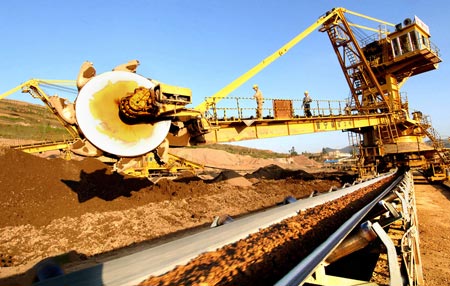China has abundant mineral resources. A total of 171 kinds of minerals have so far been discovered, of which 158 have proven reserves. These include 10 kinds of energy mineral resources such as petroleum, natural gas, coal and uranium; 54 kinds of metallic mineral resources such as iron, manganese, copper, aluminum, lead and zinc; 91 kinds of nonmetallic mineral resources such as graphite, phosphorus, sulfur and sylvine; and three kinds of water and gas mineral resources such as underground water and mineral water. Currently, the supply of over 92 percent of China's primary energy, 80 percent of its industrial raw materials and more than 70 percent of its agricultural means of production come from mineral resources.
 |
China has abundant energy and mineral resources. Pictured is a natural gas well in Tarim Oilfield, Xinjiang Uygur Autonomous Region.
Energy mineral resources China boasts rich energy mineral resources, but the structure of these types of resources is not ideal, with coal making up a large proportion while petroleum and natural gas constituting relatively small proportions.
Coal resources demonstrate such features as: huge reserves and complete varieties but uneven distribution among different grades, with small reserves of high-quality coking coal and anthracite coal; wide distribution but a great disparity in abundance for different deposit locations, with large reserves in western and northern regions and small reserves in eastern and southern regions; a small number of surface coalmines, most of which are lignite mines; and great varieties of associated minerals existing in coal seams.
Oil and gas resources have the following features: large oil reserves, which make China one of the 10 countries in the world with more than 15 billion tons of exploitable oil reserves; low proven rate, with verified onshore reserves accounting for only one fifth of the total and the proven rate for offshore reserves being even lower; and concentrated distribution, with 73 percent of the total oil resources distributed in 14 basins each covering an area of 100,000 square km and more than 50 percent of the nation's total natural gas resources distributed in central and western regions.
Metallic mineral resources China is among the countries with rich metallic mineral resources. It has proven reserves, more or less, of all kinds of metallic mineral resources that have so far been discovered worldwide. Of these, the proven reserves of tungsten, tin, antimony, rare earth, tantalum and titanium rank first in the world; those of vanadium, molybdenum, niobium, beryllium and lithium rank second; those of zinc rank fourth; and those of iron, lead, gold and silver rank fifth.
 |
Almost all discovered metal resources in the world have proven reserves in China. Pictured is an open-pit mine in Yunnan Province.
Metallic mineral resources feature wide distribution with relatively concentrated deposits in several regions. For instance, iron deposits are mainly found in three areas—Anshan-Benxi (in Liaoning Province), north Hebei Province and Shanxi Province. Bauxite reserves are mainly distributed in Shanxi, Henan and Guizhou provinces and Guangxi Zhuang Autonomous Region. Tungsten deposits are chiefly distributed in provinces of Jiangxi, Hunan and Guangdong, and tin deposits in Yunnan, Guangdong and Hunan provinces and Guangxi Zhuang Autonomous Region.
Some of China's metallic minerals such as tungsten, tin, molybdenum, antimony and rare earth have large reserves, and are of high quality and competitive in world markets. However, many important metallic minerals such as iron, manganese, aluminum and copper are of poor quality, with ores lean and difficult to smelt. Most of the metallic mineral deposits are small or medium-sized as large and super-large deposits account for a small proportion.
Nonmetallic mineral resources China is one of the few countries in the world that have a relatively complete range of nonmetallic mineral resources. Currently, there are more than 5,000 nonmetallic mineral ore production bases with proven reserves in China.
Most of the nonmetallic mineral resources in China have large proven reserves. Of them, the proven reserves of magnesite, graphite, fluorite, talc, asbestos, gypsum, barite, wollastonite, alunite, bentonite and rock salt (halite) are among the largest in the world, while those of phosphorus, kaolin, pyrite, mirabilite, tripolite, zeolite, pearlite and cement limestone hold major positions. Some natural stone materials such as marble and granite in China are of high quality, with rich reserves. However, China is relatively deficient in reserves of sylvine and boron.
Water and gas mineral resources Proven natural underground water resources in China amount to 870 billion cubic meters per year, of which 290 billion cubic meters are exploitable. The natural underground brackish water resources in China stand at 20 billion cubic meters per year.
However, China's underground water resources are not evenly distributed, with the southern region rich, and northern and western regions poor. Underground water aquifer types differ in geographical location. North China has a wide distribution of underground water resources via pore aquifers while southwestern regions see wide distribution of Karst water resources.
In 2006, national land surveys and geological explorations discovered a total of 213 new mineral deposits in large or medium size, including 42 energy mineral deposits, 85 metallic mineral mines, 85 nonmetallic mineral mines and one water and gas mineral deposit. Increased reserves were found for 72 minerals, including 944 million tons of crude oil, 538.1 billion cubic meters of natural gas and 36.7 billion tons of coal.










